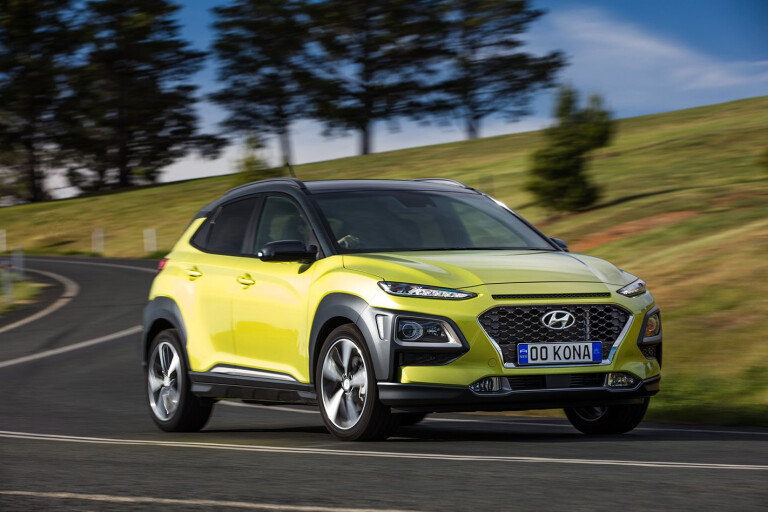
Score breakdown
Things we like
- Bold styling
- Interior space
- Zippy 1.6-litre turbo engine
Not so much
- No 2.0-litre AWD, unadventurous interior
What stands out?
The Hyundai Kona is the second smallest SUV produced by the South Korean manufacturer and features bold styling, excellent standard and optional equipment levels and a roomy cabin that seats five. A powerful 1.6-litre turbo petrol engine with all-wheel-drive is optional as is a full battery-electric version. It is covered by Hyundai’s five-year warranty. All Konas come standard with autonomous emergency braking.

What might bug me?
That you’ve partly chosen a Kona for its bold exterior styling only to find the interior is a little bland and almost identical to the i30 hatchback.
It's also not the best to drive through traffic. The turbocharged 1.6-litre is available only with a seven-speed dual-clutch auto gearbox, which will not quite match the fluid throttle inputs that you get with a conventional or CVT auto, and therefore requires a little more care in stop-start conditions.
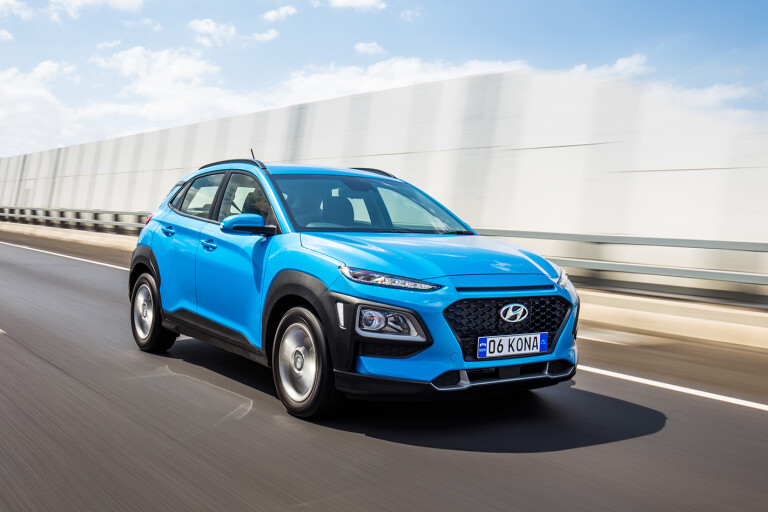
With a Kona Electric, knowing that despite its excellent range there are still places you won't be able to take it because of a lack of public charging facilities.
What body styles are there?
Five-door SUV-style wagon only.
Some Konas drive only their front wheels, while others drive all four wheels. The Kona is classed as a small SUV, lower priced.

What features do all Konas have?
- Autonomous emergency braking, forward collision warning, lane-keeping assist and driver attention alert, which are all part of Hyundai’s SmartSense active safety package.
- Cruise control, air conditioning, a reversing camera, and rear parking sensors (these help you judge how far the rear bumper is from obstacles)
- Headlights that turn on automatically when it’s getting dark, and bright, long-lived LED daytime running lights.
- A 7.0-inch touchscreen, from which you can control the six-speaker audio system. Sound sources include an AM/FM radio, aux and USB inputs, and Bluetooth phone calls and audio streaming.
- Controls on the steering wheel for the audio system.

- Support for Apple CarPlay and Android Auto, which lets you display apps from your smartphone on the car’s touchscreen and operate them from there.
- Roof rails, which make it easier to fit rooftop luggage systems.
- Hill-start assist, which operates the brakes automatically to make take-offs on steep hills easier, and downhill brake control.
- A temporary space-saving spare tyre and a tyre pressure monitor warns you if a tyre has lost air (this can give you extra time to get a slow-leaking puncture seen to). Kona Electric versions come with a puncture repair kit instead of the spare wheel.
- Six airbags. Electronic stability control, which can help you control a skidding car. (For the placement of airbags, and more on Tucson safety features, please open the Safety section below.)
- Every Hyundai Kona carries a five-year, unlimited-kilometre warranty.
Which engine uses least fuel, and why wouldn't I choose it?
There are two petrol engines in the Kona range, but of course it's the Electric versions that use the least... well no fuel.
The Kona Electric Elite and Highlander are powered by 65kWh battery that drives the electric motor that provides exceptional power and torque. It is one of the most efficient electric vehicles, with a driving range of about 440kms, or about 320km when charged at 80 percent. Some EVs have longer ranges, but they also have bigger batteries that take longer to charge.

This is an excellent electric vehicle, but the main reason you would not choose it is because of the $28,000 mark up over the 1.6-litre turbo equivalents. Then there are the limitations of driving with electric vehicles should you frequently travel long distances.
That said if you mostly drive around town you'll go at least a week before needing to charge, though with EVs it's always best to top up when possible.
If choosing one of the petrol engines, the 1.6-litre turbo-petrol is the smaller of the two but is more powerful. It uses the least fuel, consuming as little as 6.7 litres/100km on the official test (city and country combined). Each 1.6-litre turbo version drives all four wheels.
The 2.0-litre petrol engine consumes 7.2-litres/100km according to the Hyundai' claims.
The main reason you might not choose the 1.6-litre turbo is if you want to pay less for your Kona: at any equipment level, its costs around $4000 than its 2.0-litre alternative, though the price includes all-wheel-drive and a more advanced seven-speed dual-clutch automatic transmission.

A dual-clutch automatic works like a manual gearbox that’s controlled robotically. It reduces fuel use and offers very smooth shifts on the highway. But it cannot match the very fluid, elastic starts from rest that you get with a conventional automatic, which is noticeable in stop-start traffic.
(Power outputs and all other Kona specifications are available from the Cars Covered menu, under the main image on this page.)
What key features do I get if I spend more?
The Kona comes in five equipment levels; Go, Active, Active with Safety Pack, Elite and Highlander. Each has a choice of the 2.0-litre engine and front-wheel-drive powertrain, or the more costly 1.6-litre turbo all-wheel-drive.
The least costly Kona Go specification includes 16-inch steel wheels with plastic hubcaps, cloth seat trim, 7.0-inch infotainment screen, and the features available in all Konas.
Upgrading to the Kona Active brings 16-inch better-looking aluminium alloy wheels, an 8.0-inch touchscreen with in-built satellite navigation with traffic information, and leather-appointed steering wheel and gear knob and an eight-speaker premium audio system.

The Kona Elite spec gains you:
- Leather on the seats (there is a mix of real and fake leather
- Adaptive cruise control, blind-spot monitor, and rear-cross traffic alert are added to the SmartSense active safety package.
- Dual-zone climate control allows you to set different temperatures for each side of the cabin, and you can listen to DAB+ digital radio.
- Wheel diameter grows an inch to 17 inches, and the correspondingly lower profile tyres look sportier and sharpen the steering slightly.
- You also get keyless entry and push-button start, front fog lights, rain-sensing windscreen wipers, a luggage net and power-folding, heated side mirrors.
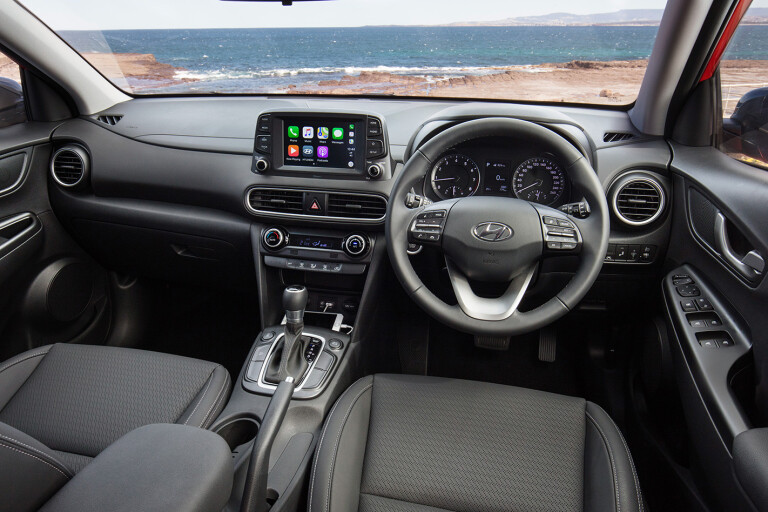
The Elite also differs externally with carbon grey side skirts and wheel arches, and a rear metallic skid plate.
Going for a Kona Highlander brings high beam assist, which automatically dims when sensing vehicles ahead.
The Highlander also gains a power-operated sunroof (not available in the Electric version), power adjustment for the front seats, heating and ventilation to both front seats, a heated steering wheel and a head-up display lets you see your speed and other driving information near eye level on the windscreen.
Other extras include longer-lasting LED headlights, front indicators and tail lights, auto-dimming mirror, a wireless charging pad for your phone and sportier 18-inch wheels
Does any upgrade have a down side?
The Kona Active models ride more comfortably on their 16-inch wheels than the Elite and Highlander ride on their 17s and 18s, because the lower-profile tyres on the bigger wheels have less rubber and air cushioning the wheels from the road. The difference is most pronounced at city speeds.
The Kona Electric versions have a smaller cargo area because of the batteries stored underneath the boot space. This also means there is no space for a spare tyre which means they're equipped with a puncture repair kit.
How comfortable is the Kona?
The Hyundai Kona is surprisingly big inside. Space in the rear is very good for a car of this size, with two six-footers easily accommodated. Front headroom is excellent.
The cabin is similar to the Hyundai i30 and, aside from the inconveniently-situated starter button on upper-spec models, the ergonomics are sound especially the layout of the steering wheel-mounted controls.
Ride quality on the Australian-tuned suspension is on the firm side, but you’ll only feel significant jolts over sharper road imperfections.
What about safety in the Kona?
Anti-lock brakes, stability control, a strong body, six airbags, a reversing camera, and seatbelt reminders for all positions, are solid safety fundamentals in all Hyundai Konas.
The airbags are in the usual places: two directly in front of the driver and front passenger; one alongside each front occupant at chest level to protect from side impacts; and a curtain airbag down each side protecting the heads of front and rear occupants.
All Konas have active safety as part of the Hyundai SmartSense package, including automatic emergency braking, which warns you of obstacles in front of the car, such as a slower vehicle, and applies the brakes automatically if you do not react. The Kona’s auto-braking system will bring it to stop from speeds up to 75km/h, and mitigates the impact of a collision at higher speeds.
Hyundai SmartSense in the Elite and Highlander Konas also includes blind-spot detection, which warns when a vehicle is alongside out of view. Blind Spot Warning alerts you if a vehicle in an adjacent lane is approaching quickly from behind.
Lane departure warning lets you know that you are drifting distractedly out of your lane (a sign of fatigue), and lane-keeping assist acts on the steering to help you bring the car back.
A rear cross-traffic alert warns when reversing that something is crossing your path, which could save you from car-park bingles. Smart (adaptive) Cruise Control utilises the front radar sensor to detect the speed and distance of vehicles ahead and automatically maintain a safe distance up to a pre-set speed by the driver (between 30km/h – 180km/h).
The Hyundai Kona scored five stars out of five in the Australian New Car Assessment Program crash test.

I like driving - will I enjoy the Kona?
Yes. If you’re after a spirited drive, the 1.6-litre turbo engine, which is similar to the one in the bigger Tucson, rarely feels short of power. And it has a Sport driving mode that gives it even more oomph.
The 2.0-litre engine, which is expected to be the biggest seller, takes a bit longer to get up to speed, but it feels much more in sync with its six-speed automatic transmission.
The 1.6 has all-wheel-drive traction and a more advanced suspension set up than the 2.0-litre, however, there isn’t too much difference between them in terms of ride quality; which is on the firm side, but absorbs all but the sharpest bumps and ridges well.

Ride and handling is OK but not as polished as some of its competitors, such as the Mazda CX-3, which feels like a sporty hatch.
The brakes are impressive, with real bite and great pedal feel.
The Kona Electric versions are arguably more fun to drive, with much quicker acceleration and seemingly limitless power. They handle nicely and on bendy roads; the regenerative braking offers enough slowing power when needed, so you rarely have to apply the actual breaks even on downhills.
The Kona Electric versions on the other hand have a soft ride that's obviously been tuned for smooth urban roads where the ride can be quite serene. However, the ride gets very choppy on rougher surfaces.
How is life in the rear seats?
The Kona is surprisingly big inside for a small SUV. The rear seats have more than adequate leg and headroom and accommodate two adults comfortably. The middle seat is tight, but will easily accommodate a child.
The rising door line hampers side vision a little, but the cabin otherwise feels quite airy.
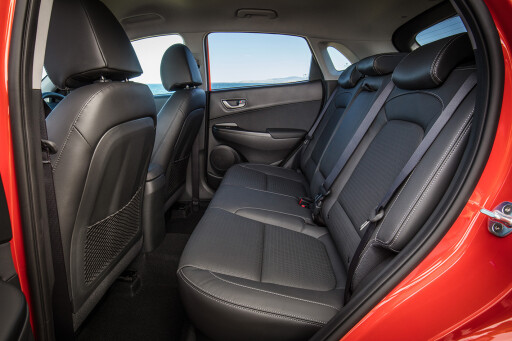
Rear seat passengers have their own rear air vents, though there are no dedicated USB or 12v sockets to charge mobile devices.
Rear seat storage includes door bins with bottle holders, seat pockets behind the front seats and two cupholders in the fold-down centre armrest.
How is Kona for carrying stuff?
With the second-row seats upright, the Kona’s cargo bay holds 361-litres with cover in place, which is about the average size for a small SUV. With the second-row seats folded down, the capacity is 1143 litres. The rear opening is nice and wide to help with loading bulky objects.
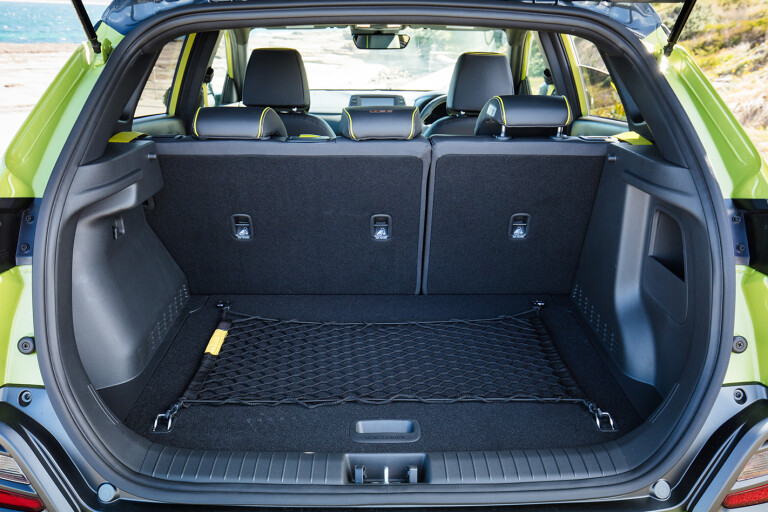
The Kona Electric versions lose 29 litres of boot space because of the shallow boot floor required to accommodate the battery.
Where is it the Kona made?
The Hyundai Kona is built in South Korea.
Are there any rivals I should consider?
If you like the Kona you may also want to consider other stylish small-SUVs including the Honda HR-V, Mazda CX-3, Peugeot 2008, Subaru XV and Toyota C-HR. There is also the smaller and more affordable Hyundai Venue.
The Kona Electric is pretty much on its own as far as battery-electric small SUVs are concerned, but you might want to look at the Nissan Leaf hatchback or Hyundai Ioniq if you want to spend a little less.
I like this car, but I can't choose which version. Can you help?
We like the mid-level Kona Elite with the turbo petrol 1.6 engine and all-wheel drive. The Elite brings a big boost in equipment, but is still reasonably priced for a well-equipped small SUV.
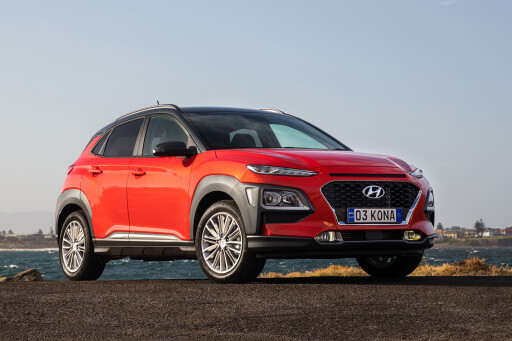
If performance isn’t too important you can get all the same features in the Elite with the 2.0-litre engine for around $4000 less.
Having said that, if the cost wasn't an issue, we'd happily recommend the either Hyundai Kona Electric, which for the price is one of better electric cars on the market.
Are there plans to update this model soon?
The Hyundai Kona first went on sale in Australia in October 2017, for the 2018 model year.
Hyundai added a new entry-level Kona Go as part of the MY19 upgrade in July 2018, which also saw the Active, Elite and Highlander gain the bigger 8.0-inch infotainment screen and satellite navigation.
The Kona Electric was introduced in early 2019 with many of the features found in the petrol Kona range.
In September 2019 Hyundai made active safety, including autonomous emergency braking and lane-keeping assist, to the cheaper Go and Active versions for the 2020 model year. The Elite and Highlander gained active cruise control.
---04.jpg)
Hyundai announced a major facelift for the Kona (above) in September 2020, which will arrive on Australian roads in the first quarter of 2021. This will include a sporty trimmed N-Line version. The Kona Electrics will also receive a new look.
Score breakdown
Things we like
- Bold styling
- Interior space
- Zippy 1.6-litre turbo engine
Not so much
- No 2.0-litre AWD, unadventurous interior

COMMENTS